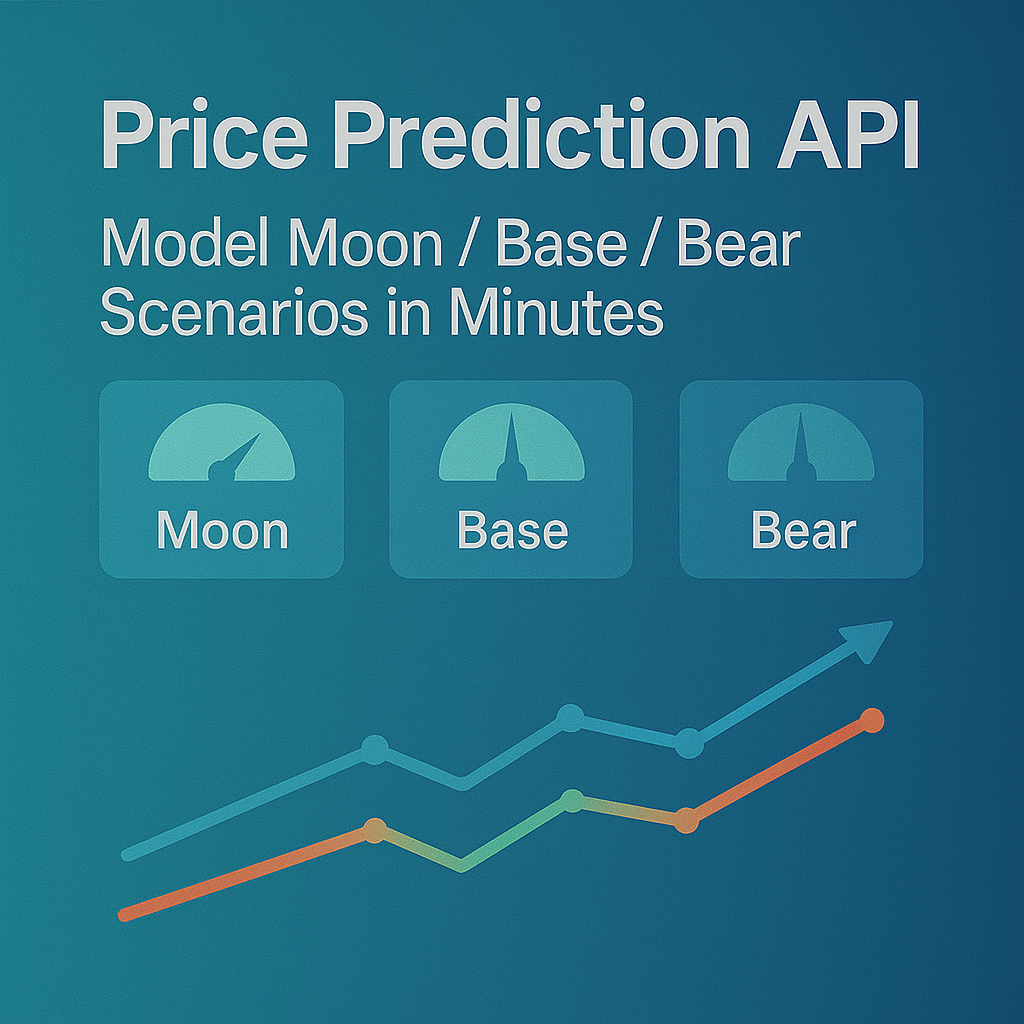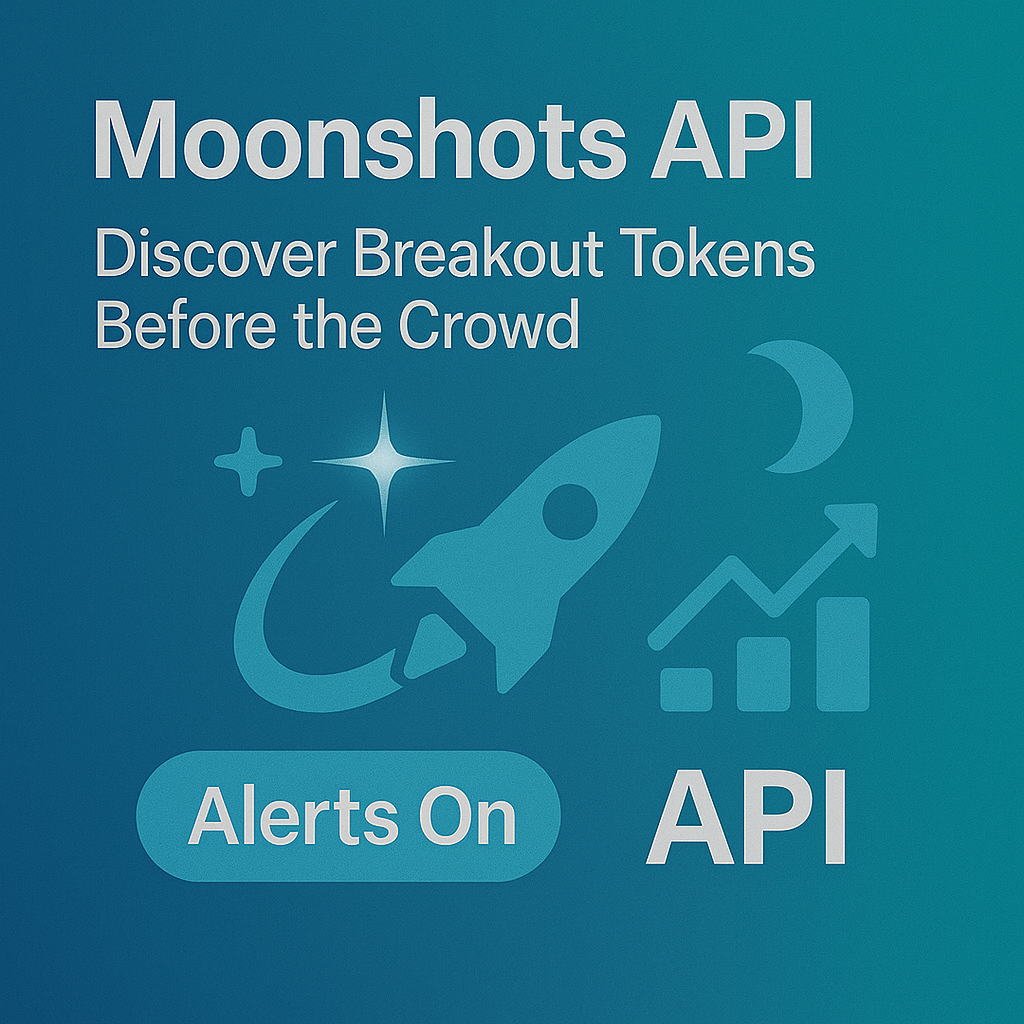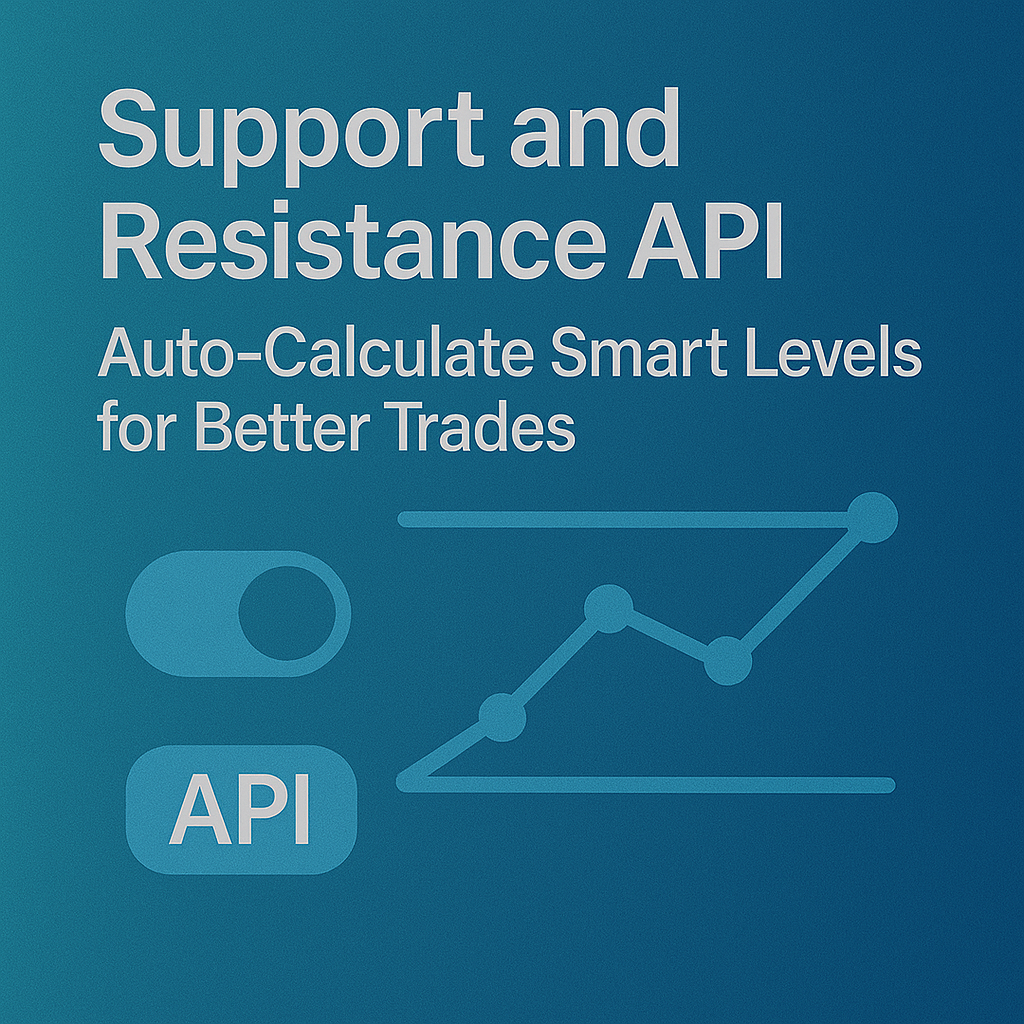Top Crypto Trading Platforms in 2025







%201.svg)
%201.svg)
Big news: We’re cranking up the heat on AI-driven crypto analytics with the launch of the Token Metrics API and our official SDK (Software Development Kit). This isn’t just an upgrade – it's a quantum leap, giving traders, hedge funds, developers, and institutions direct access to cutting-edge market intelligence, trading signals, and predictive analytics.
Crypto markets move fast, and having real-time, AI-powered insights can be the difference between catching the next big trend or getting left behind. Until now, traders and quants have been wrestling with scattered data, delayed reporting, and a lack of truly predictive analytics. Not anymore.
The Token Metrics API delivers 32+ high-performance endpoints packed with powerful AI-driven insights right into your lap, including:
Getting started with the Token Metrics API is simple:
At Token Metrics, we believe data should be decentralized, predictive, and actionable.
The Token Metrics API & SDK bring next-gen AI-powered crypto intelligence to anyone looking to trade smarter, build better, and stay ahead of the curve. With our official SDK, developers can plug these insights into their own trading bots, dashboards, and research tools – no need to reinvent the wheel.
%201.svg)
%201.svg)
The biggest gains in crypto rarely come from the majors. They come from Moonshots—fast-moving tokens with breakout potential. The Moonshots API surfaces these candidates programmatically so you can rank, alert, and act inside your product. In this guide, you’ll call /v2/moonshots, display a high-signal list with TM Grade and Bullish tags, and wire it into bots, dashboards, or screeners in minutes. Start by grabbing your key at Get API Key, then Run Hello-TM and Clone a Template to ship fast.
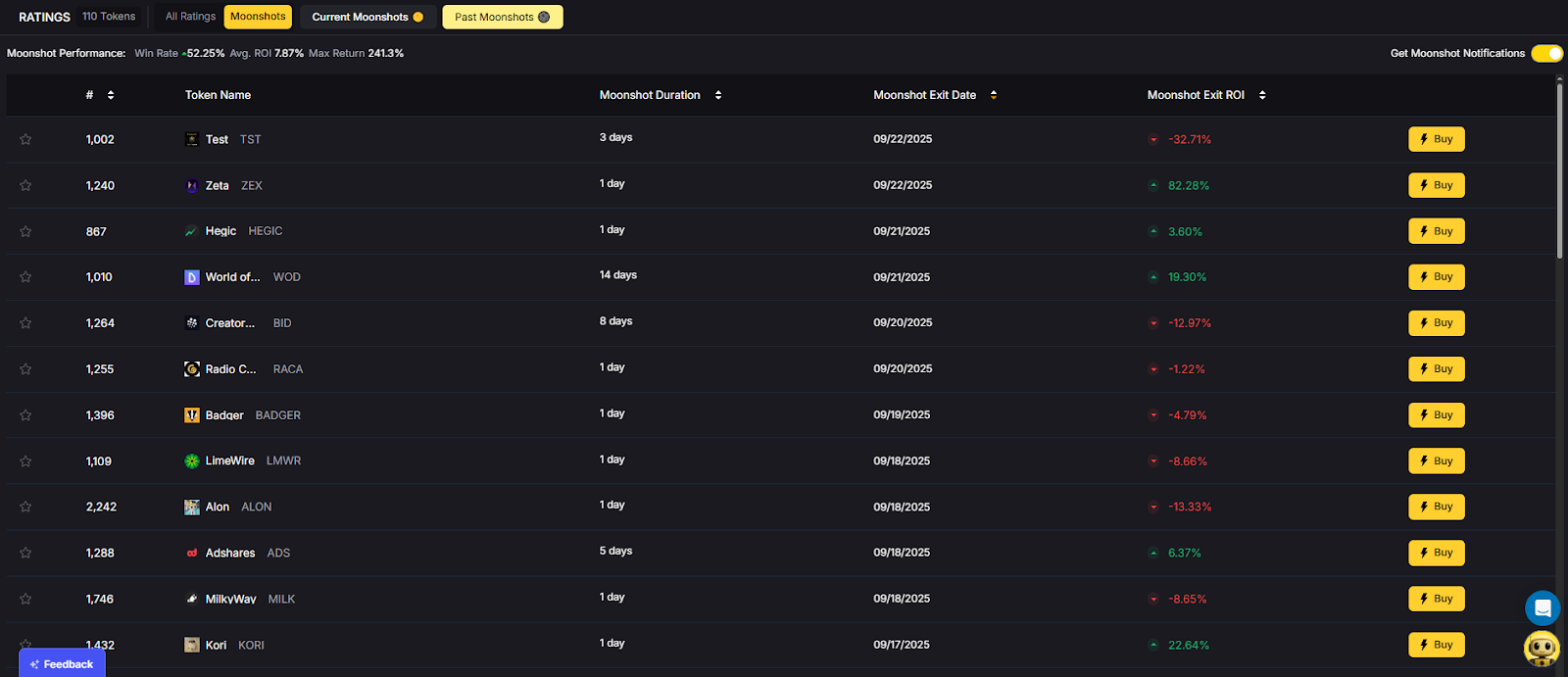
Discovery that converts. Users want more than price tickers—they want a curated, explainable list of high-potential tokens. The moonshots API encapsulates multiple signals into a short list designed for exploration, alerts, and watchlists you can monetize.
Built for builders. The endpoint returns a consistent schema with grade, signal, and context so you can immediately sort, badge, and trigger workflows. With predictable latency and clear filters, you can scale to dashboards, mobile apps, and headless bots without reinventing the discovery pipeline.
The Moonshots API cURL request is right there in the top right of the API Reference. Grab it and start tapping into the potential!
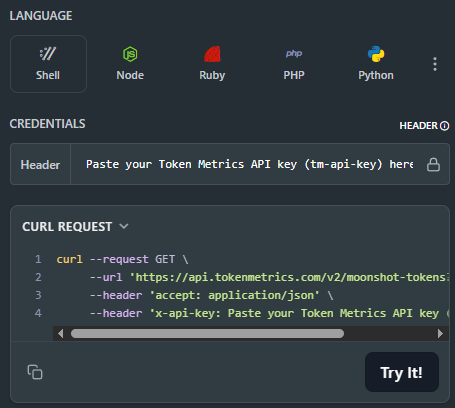
👉 Keep momentum: Get API Key • Run Hello-TM • Clone a Template
Fork a screener or alerting template, plug your key, and deploy. Validate your environment with Hello-TM. When you scale users or need higher limits, compare API plans.
The Moonshots endpoint aggregates a set of evidence—often combining TM Grade, signal state, and momentum/volume context—into a shortlist of breakout candidates. Each row includes a symbol, grade, signal, and timestamp, plus optional reason tags for transparency.
For UX, a common pattern is: headline list → token detail where you render TM Grade (quality), Trading Signals (timing), Support/Resistance (risk placement), Quantmetrics (risk-adjusted performance), and Price Prediction scenarios. This lets users understand why a token was flagged and how to act with risk controls.
Polling vs webhooks. Dashboards typically poll with short-TTL caching. Alerting flows use scheduled jobs or webhooks (where available) to smooth traffic and avoid duplicates. Always make notifications idempotent.
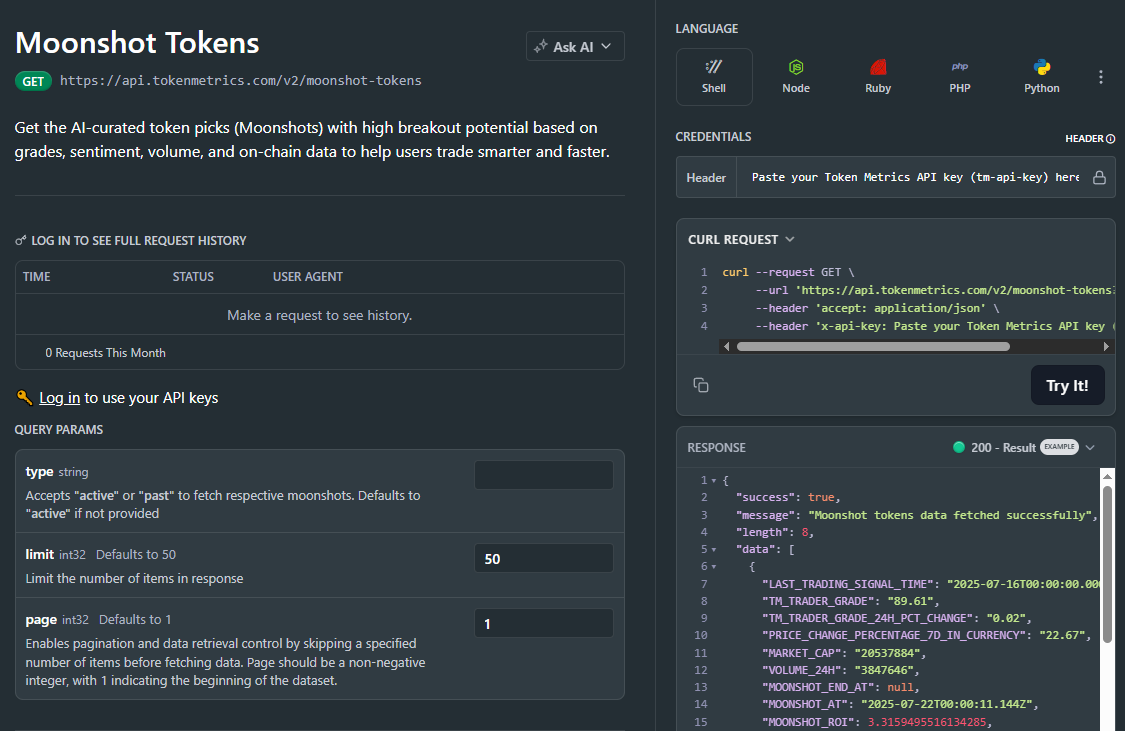
1) What does the Moonshots API return?
A list of breakout candidates with fields such as symbol, tm_grade, signal (often Bullish/Bearish), optional reason tags, and updated_at. Use it to drive discover tabs, alerts, and watchlists.
2) How fresh is the list? What about latency/SLOs?
The endpoint targets predictable latency and timely updates for dashboards and alerts. Use short-TTL caching and queued jobs/webhooks to avoid bursty polling.
3) How do I use Moonshots in a trading workflow?
Common stack: Moonshots for discovery, Trading Signals for timing, Support/Resistance for SL/TP, Quantmetrics for sizing, and Price Prediction for scenario context. Always backtest and paper-trade first.
4) I saw results like “+241%” and a “7.5% average return.” Are these guaranteed?
No. Any historical results are illustrative and not guarantees of future performance. Markets are risky; use risk management and testing.
5) Can I filter the Moonshots list?
Yes—pass parameters like min_grade, signal, and limit (as supported) to tailor to your audience and keep pages fast.
6) Do you provide SDKs or examples?
REST works with JavaScript and Python snippets above. Docs include quickstarts, Postman collections, and templates—start with Run Hello-TM.
7) Pricing, limits, and enterprise SLAs?
Begin free and scale up. See API plans for rate limits and enterprise options.
%201.svg)
%201.svg)
Most traders still draw lines by hand in TradingView. The support and resistance API from Token Metrics auto-calculates clean support and resistance levels from one request, so your dashboard, bot, or alerts can react instantly. In minutes, you’ll call /v2/resistance-support, render actionable levels for any token, and wire them into stops, targets, or notifications. Start by grabbing your key on Get API Key, then Run Hello-TM and Clone a Template to ship a production-ready feature fast.
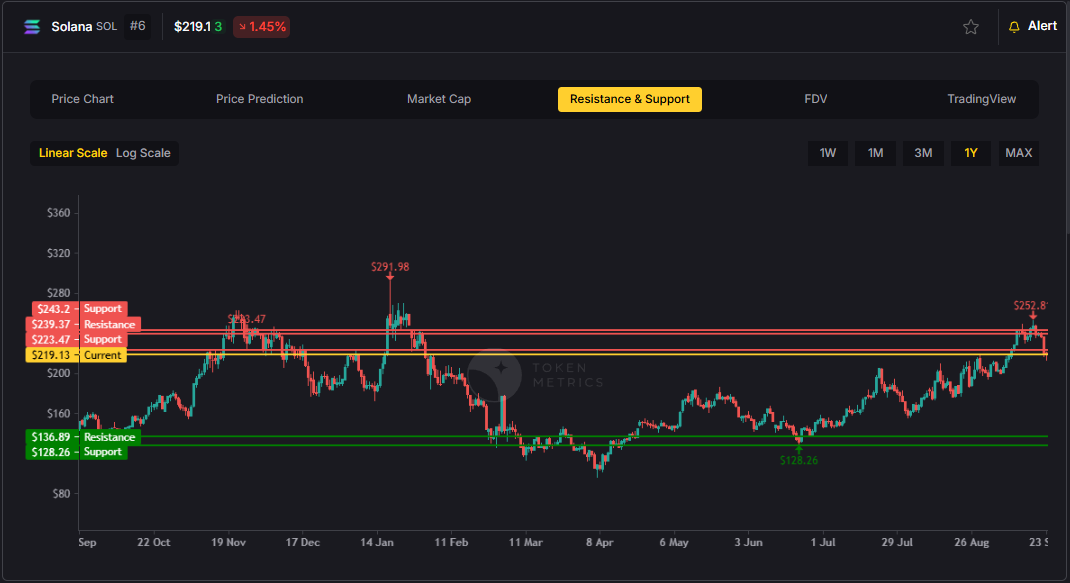
Precision beats guesswork. Hand-drawn lines are subjective and slow. The support and resistance API standardizes levels across assets and timeframes, enabling deterministic stops and take-profits your users (and bots) can trust.
Production-ready by design. A simple REST shape, predictable latency, and clear semantics let you add levels to token pages, automate SL/TP alerts, and build rule-based execution with minimal glue code.
Need the Support and Resistance data? The cURL request for it is in the top right of the API Reference for quick access.
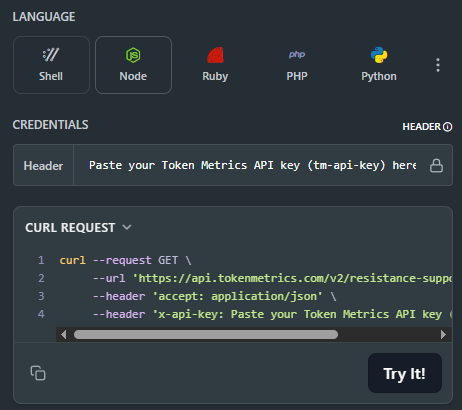
👉 Keep momentum: Get API Key • Run Hello-TM • Clone a Template
Kick off with our quickstarts—fork a bot or dashboard template, plug your key, and deploy. Confirm your environment by Running Hello-TM. When you’re scaling or need webhooks/limits, review API plans.
The Support/Resistance endpoint analyzes recent price structure to produce discrete levels above and below current price, along with strength indicators you can use for priority and styling. Query /v2/resistance-support?symbol=<ASSET>&timeframe=<HORIZON> to receive arrays of level objects and timestamps.
Polling vs webhooks. For dashboards, short-TTL caching and batched fetches keep pages snappy. For bots and alerts, use queued jobs or webhooks (where applicable) to avoid noisy, bursty polling—especially around market opens and major events.
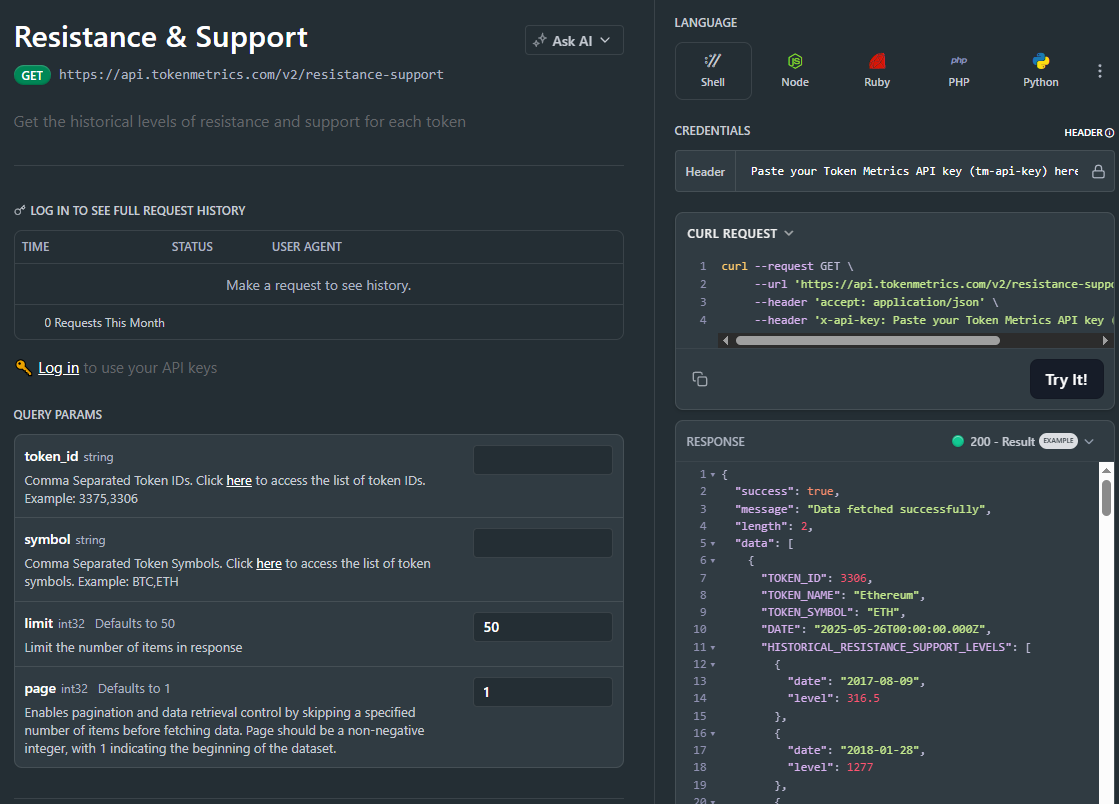
1) What does the Support & Resistance API return?
A JSON payload with arrays of support and resistance levels for a symbol (and optional timeframe), each with a price and strength indicator, plus an update timestamp.
2) How timely are the levels? What are the latency/SLOs?
The endpoint targets predictable latency suitable for dashboards and alerts. Use short-TTL caching for UIs, and queued jobs or webhooks for alerting to smooth traffic.
3) How do I trigger alerts or trades from levels?
Common patterns: alert when price is within X% of a level, touches a level, or breaks beyond with confirmation. Always make downstream actions idempotent and respect rate limits.
4) Can I combine levels with other endpoints?
Yes—pair with /v2/trading-signals for timing, /v2/tm-grade for quality context, and /v2/quantmetrics for risk sizing. This yields a complete decide-plan-execute loop.
5) Which timeframe should I use?
Intraday bots prefer shorter horizons; swing/position dashboards use daily or higher-timeframe levels. Offer a timeframe toggle and cache results per setting.
6) Do you provide SDKs or examples?
Use the REST snippets above (JS/Python). The docs include quickstarts, Postman collections, and templates—start with Run Hello-TM.
7) Pricing, limits, and enterprise SLAs?
Begin free and scale as you grow. See API plans for rate limits and enterprise SLA options.
%201.svg)
%201.svg)
Most traders see price—quants see probabilities. The Quantmetrics API turns raw performance into risk-adjusted stats like Sharpe, Sortino, volatility, drawdown, and CAGR so you can compare tokens objectively and build smarter bots and dashboards. In minutes, you’ll query /v2/quantmetrics, render a clear performance snapshot, and ship a feature that customers trust. Start by grabbing your key at Get API Key, Run Hello-TM to verify your first call, then Clone a Template to go live fast.
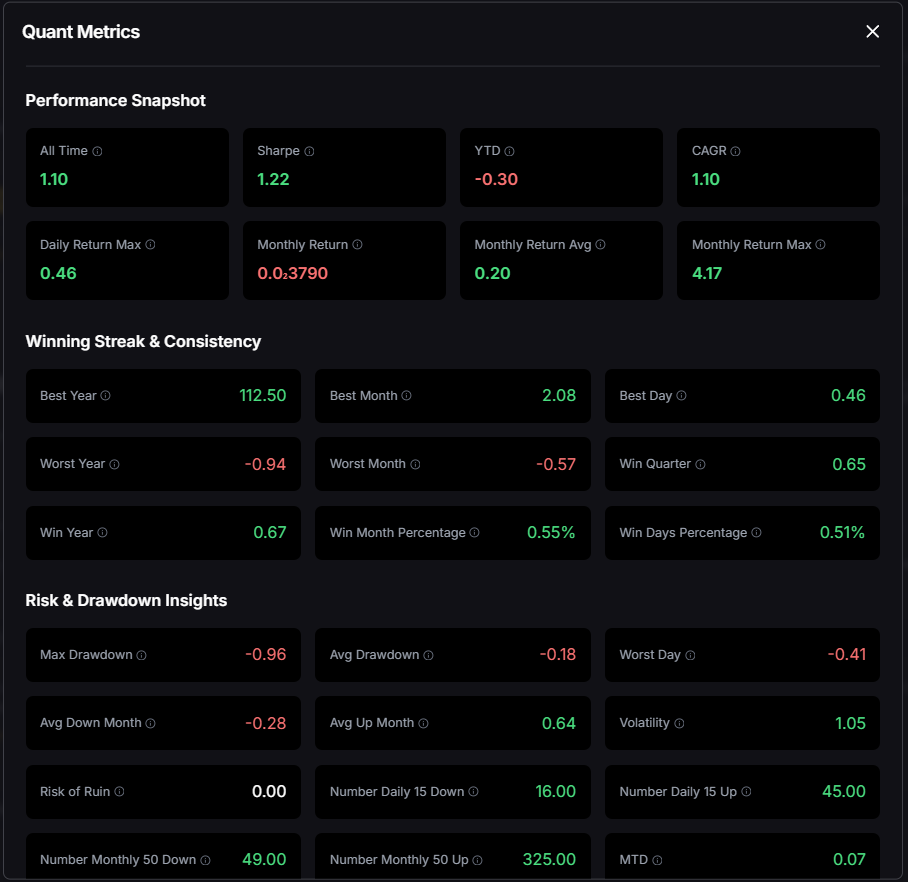
Risk-adjusted truth beats hype. Price alone hides tail risk and whipsaws. Quantmetrics compresses edge, risk, and consistency into metrics that travel across assets and timeframes—so you can rank universes, size positions, and communicate performance like a pro.
Built for dev speed. A clean REST schema, predictable latency, and easy auth mean you can plug Sharpe/Sortino into bots, dashboards, and screeners without maintaining your own analytics pipeline. Pair with caching and batching to serve fast pages at scale.
The Quant Metrics cURL request is located in the top right of the API Reference, allowing you to easily integrate it with your application.
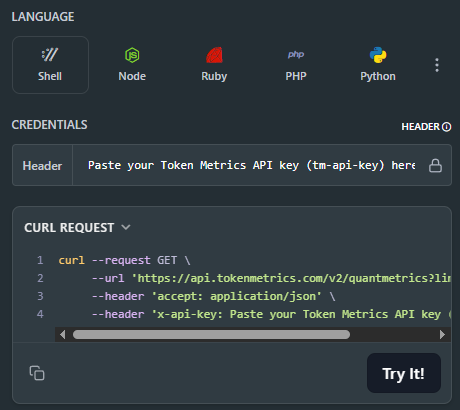
👉 Keep momentum: Get API Key • Run Hello-TM • Clone a Template
Kick off from quickstarts in the docs—fork a dashboard or screener template, plug your key, and deploy in minutes. Validate your environment with Run Hello-TM; when you need more throughput or webhooks, compare API plans.
Quantmetrics computes risk-adjusted performance over a chosen lookback (e.g., 30d, 90d, 1y). You’ll receive a JSON snapshot with core statistics:
Call /v2/quantmetrics?symbol=<ASSET>&window=<LOOKBACK> to fetch the current snapshot. For dashboards spanning many tokens, batch symbols and apply short-TTL caching. If you generate alerts (e.g., “Sharpe crossed 1.5”), run a scheduled job and queue notifications to avoid bursty polling.
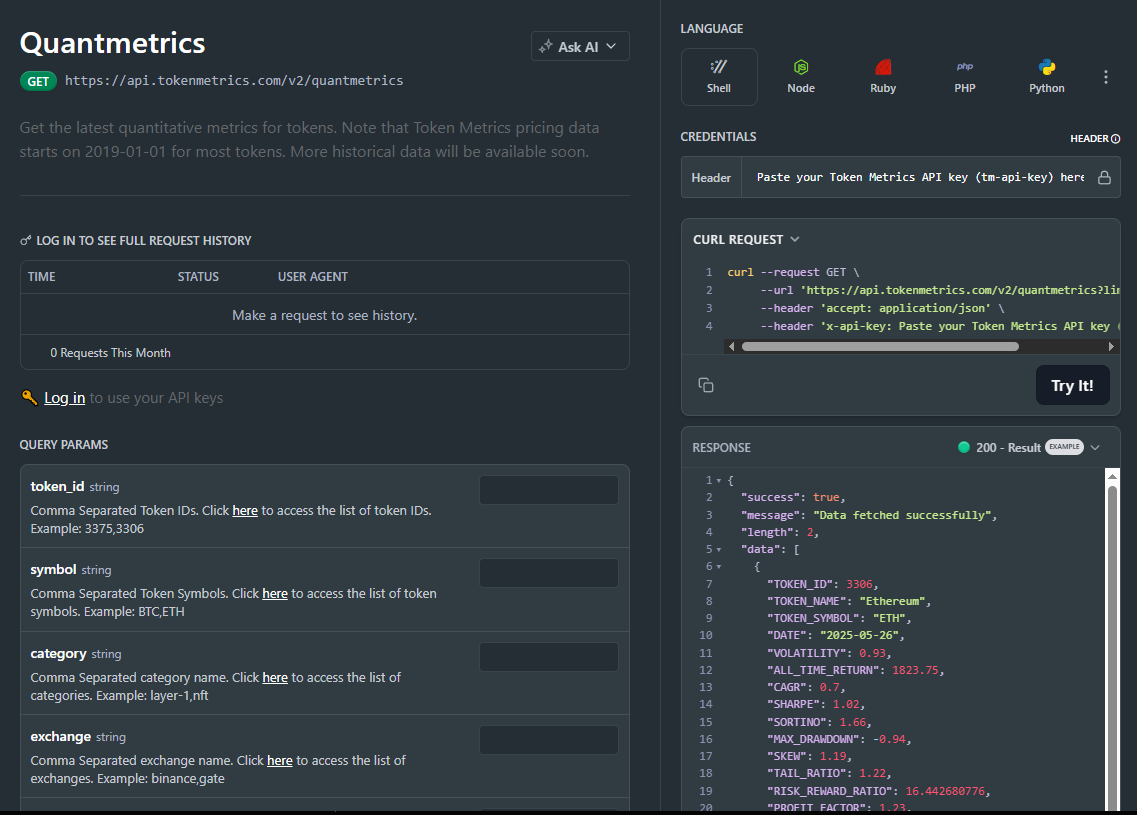
1) What does the Quantmetrics API return?
A JSON snapshot of risk-adjusted metrics (e.g., Sharpe, Sortino, volatility, max drawdown, CAGR) for a symbol and lookback window—ideal for ranking, sizing, and dashboards.
2) How fresh are the stats? What about latency/SLOs?
Responses are engineered for predictable latency. For heavy UI usage, add short-TTL caching and batch requests; for alerts, use scheduled jobs or webhooks where available.
3) Can I use Quantmetrics to size positions in a live bot?
Yes—many quants size inversely to volatility or require Sharpe ≥ X to trade. Always backtest and paper-trade before going live; past results are illustrative, not guarantees.
4) Which lookback window should I choose?
Short windows (30–90d) adapt faster but are noisier; longer windows (6–12m) are steadier but slower to react. Offer users a toggle and cache each window.
5) Do you provide SDKs or examples?
REST is straightforward (JS/Python above). Docs include quickstarts, Postman collections, and templates—start with Run Hello-TM.
6) Polling vs webhooks for quant alerts?
Dashboards usually use cached polling. For threshold alerts (e.g., Sharpe crosses 1.0), run scheduled jobs and queue notifications to keep usage smooth and idempotent.
7) Pricing, limits, and enterprise SLAs?
Begin free and scale up. See API plans for rate limits and enterprise SLA options.
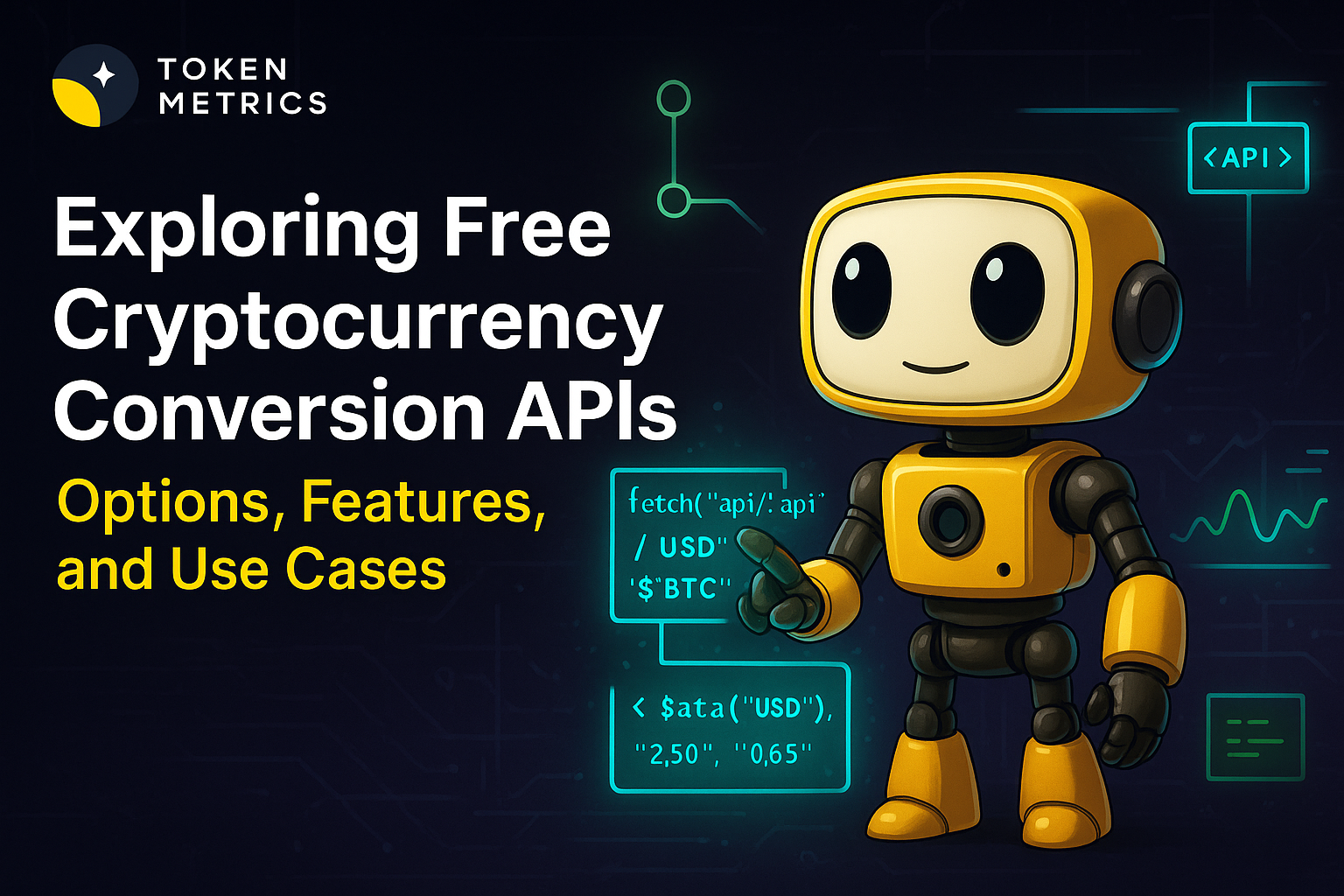
%201.svg)
%201.svg)
Developers and blockchain enthusiasts increasingly need fast, accurate, and readily available cryptocurrency conversion data. Whether you’re building a lightweight portfolio tracker, a pricing widget, or conducting academic research, access to real-time or historical exchange rates can be vital. But with so many providers and pricing tiers, many wonder: are there any free cryptocurrency conversion APIs available—and how reliable are they?
Cryptocurrency conversion APIs are interfaces that deliver digital asset exchange rates, enabling applications or analysts to retrieve crypto-to-crypto or crypto-to-fiat price data programmatically. APIs are fundamental in supporting wallets, trading bots, payment gateways, and data aggregation platforms. Their core function is to streamline access to dynamic market rates, sometimes offering additional features like historical data, volume metrics, or aggregated prices across multiple exchanges.
APIs typically respond in JSON or XML, making integration straightforward for most modern development stacks. Depending on the provider, endpoints might include real-time spot prices, conversion endpoints (i.e., "convert BTC to USD"), and even rate limits or attribution requirements. Free APIs, in particular, often balance accessibility with reasonable restrictions to maintain sustainability.
There are several reputable free options available to developers and crypto enthusiasts looking for conversion data without incurring upfront costs. Here are some of the best-known free cryptocurrency conversion APIs, the features they offer, and their typical limitations:
While many prominent APIs have free tiers, pay attention to their respective limitations. These can include request rate caps (e.g., 10-100 requests per minute), limited historical data access, attribution stipulations, and restrictions on commercial use.
When selecting a free cryptocurrency conversion API, consider several practical criteria:
For most personal and non-commercial projects, free crypto conversion APIs suffice. For production-grade applications or platforms processing sensitive or high-frequency applications (such as trading bots or financial dashboards), evaluating paid or enterprise solutions is advisable due to stronger SLAs, data consistency, and direct support channels.
Integration is generally user-friendly: developers request an API key (often free for basic tiers), review documentation, and call specified endpoints via HTTP. For example, a GET request to a provider’s conversion endpoint might return live ETH/USD prices in JSON, easily processed by web apps or scripts.
Advanced use cases extend beyond basic conversion:
For enhanced analysis or deeper risk factor evaluation, AI-powered solutions like Token Metrics can be layered atop raw market data, providing pattern recognition and enhanced filtering based on market or on-chain indicators.
The ecosystem for free crypto APIs is evolving rapidly. Increasing demand for multi-chain coverage, faster refresh rates, and predictive analytics is steering API providers toward smarter, more robust solutions, sometimes powered by artificial intelligence and real-time on-chain analytics. Open APIs and robust data-sharing agreements may become more standardized, while privacy and compliance requirements around data storage will become more relevant—especially with increased regulatory scrutiny in the crypto sector.
Platforms that merge conversion capabilities with deep analytics—such as APIs that factor in risk indicators, whale tracking, or sentiment—are gaining traction among developers. The integration of AI not only improves accuracy but empowers users to extract actionable insights without manually analyzing gigabytes of raw data.
Build Smarter Crypto Apps & AI Agents with Token Metrics
Token Metrics provides real-time prices, trading signals, and on-chain insights all from one powerful API. Grab a Free API Key
Yes, several providers offer free access to crypto conversion and price data. Commonly, these come with request rate limits, licensing, or attribution requirements. For commercial and high-frequency use, review each API’s terms carefully.
Free APIs often rely on aggregated or third-party exchange data. For most casual or research purposes, accuracy is sufficient, but there may be minor lag vs. premium feeds. Reliability also varies by provider and demand spikes.
Some APIs allow limited commercial use even on free plans, but others strictly prohibit this. Always read the Terms of Service and privacy policy of your chosen provider before deploying in production.
Key differentiators include the breadth of coins/currencies supported, response latency, ease of integration, frequency of updates, and clear documentation—with special attention paid to limits and permitted use cases.
Token Metrics offers advanced AI-powered analytics, ratings, and data tools for both developers and analysts. Its robust API supports real-time price data, in-depth insights, and integration capabilities for smarter crypto applications.
This blog post is for informational and educational purposes only. It does not constitute financial, investment, or legal advice. Always review third-party API terms, and consult with technical or legal experts when building crypto platforms.
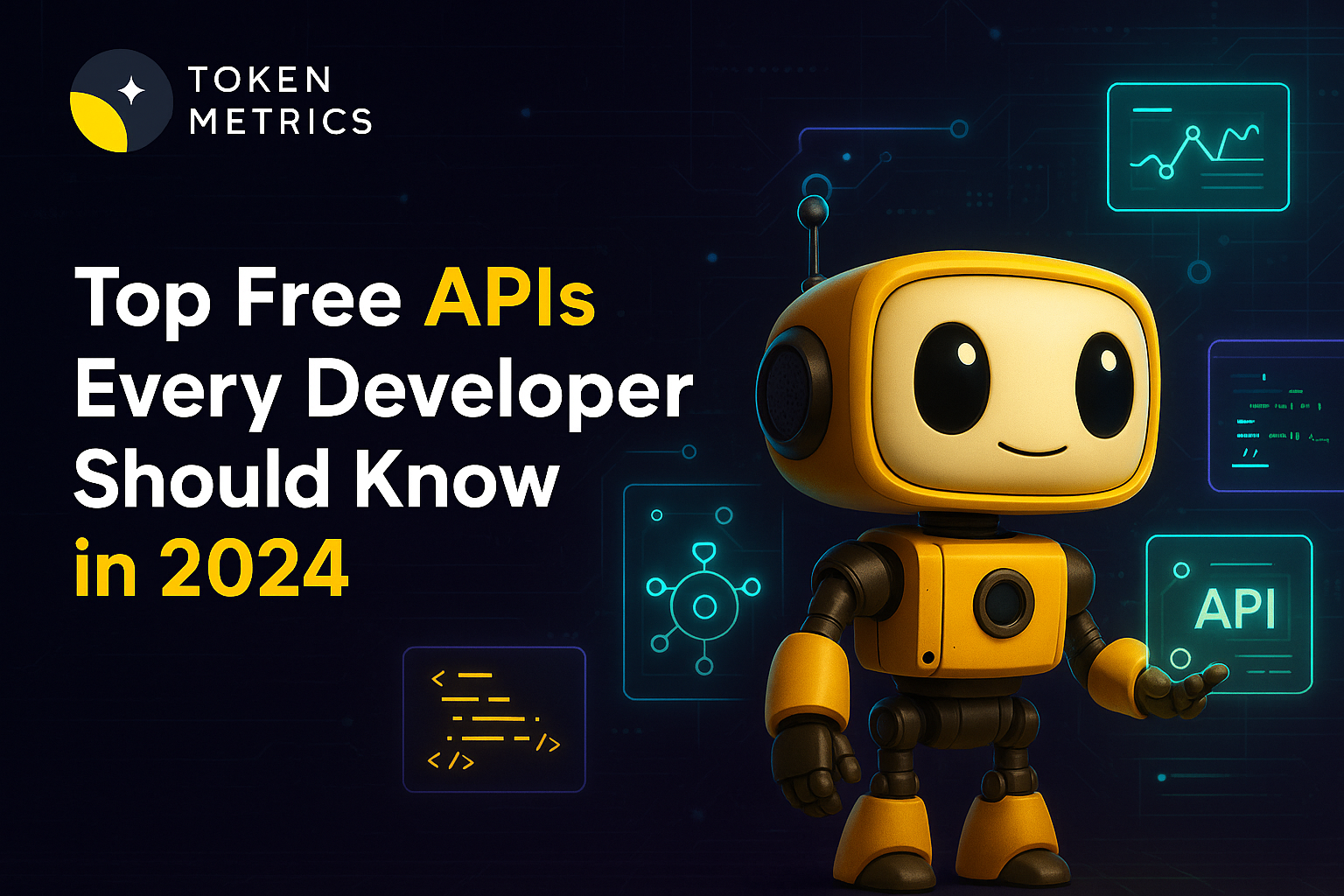
%201.svg)
%201.svg)
APIs are the silent workhorses powering today’s most innovative software. Whether you’re a crypto enthusiast automating portfolio analysis, or a web developer looking to enrich your app with real-time data, the right free API can supercharge your project—and your productivity. But with thousands out there, which free APIs truly stand out for reliability, ease of use, and breadth of features?
APIs—Application Programming Interfaces—allow applications to seamlessly interact, share insights, and build on each other's strengths. The best free-to-use APIs democratize access to powerful datasets, functionalities, and market signals. For crypto, AI, fintech, or simply creative digital projects, high-quality APIs can:
However, not all free APIs are created equal. Some offer limited usage tiers, outdated data, or spotty reliability. That’s why informed selection is crucial, especially for mission-critical apps.
The crypto landscape thrives on transparency and timely data. For enthusiasts building bots, dashboards, or research tools, these free APIs consistently earn praise:
These APIs are often foundational building blocks for portfolio trackers, on-chain analytics, and even education platforms. Crucially, they’re maintained, well-documented, and support broad application ranges without requiring payment—or personal information—at the entry level.
If your project stretches beyond crypto, the open web is full of powerful (yet freely accessible) APIs for various domains:
These tools let you build everything from machine learning prototypes to hobbyist weather notifiers. Carefully review usage limits and (where relevant) data privacy arrangements as you scale your innovation.
Not every free API is equally reliable or secure. Situations to consider include:
When integrating, secure your keys in environment variables, use HTTPS endpoints, and avoid exposing credentials in public sources. Always plan for error handling and fail-safes.
The explosion of AI-generated insights and predictive analytics owes much to accessible APIs. With free endpoints for data labeling, model inference, and sentiment tracking, even small development teams can launch powerful, AI-enhanced products. Projects like Hugging Face’s free models hub or the OpenAI playground democratize once-complex capabilities, unlocking new digital frontiers for research and public good.
For crypto analysis, AI-backed APIs—like those from Token Metrics—combine quantitative techniques and machine learning to highlight actionable trends and on-chain activity. As free API ecosystems expand, expect an even richer toolbox for developers at every skill level.
Build Smarter Crypto Apps & AI Agents with Token Metrics
Token Metrics provides real-time prices, trading signals, and on-chain insights all from one powerful API. Grab a Free API Key
APIs let different software systems communicate and share data or services. In crypto, APIs deliver live price data, transaction histories, and on-chain analytics. In AI, APIs allow access to model inference, data labeling, and natural language processing, lowering barriers for developers and researchers.
Many free APIs maintain high uptime and data accuracy, especially those from reputable organizations. However, they may have stricter rate limits, fewer support options, or evolving terms. For mission-critical operations, always implement redundancy and review official service level commitments.
Popular options include CoinGecko, CoinMarketCap, and Etherscan for price and blockchain data. For AI-driven insights, platforms like Token Metrics provide actionable intelligence with robust free tiers.
Never hardcode keys in public repos or client-side code. Use secure storage (environment variables or vaults), enforce HTTPS, rotate keys regularly, and monitor API access logs to identify anomalies.
Review documentation, data freshness, rate limits, provider reputation, privacy compliance, and supported SDKs. Test endpoints in your dev environment and plan for graceful error handling to ensure resilience.
This article is for informational purposes only and does not constitute financial, investment, or legal advice. Always perform due diligence when evaluating APIs, tools, or digital assets. No endorsement is implied. Third-party API providers may change terms at any time; verify details before production use.

%201.svg)
%201.svg)
The rapid evolution of cryptocurrencies and blockchain technology has transformed the programmer's toolkit. With thousands of coins, myriad chains, and constantly changing data, developers face a unique set of challenges—and opportunities—for innovation. Access to robust APIs, powerful software tools, and automation frameworks is now the backbone of successful crypto development. But which tools and APIs stand out, and how can programmers leverage them most effectively?
APIs are the connective tissue of crypto ecosystems, granting developers access to everything from real-time prices to on-chain analytics. Leading APIs for general-purpose crypto data include:
When evaluating APIs, focus on latency, coverage, reliability, and pricing. For power users, combining multiple APIs—one for fast price ticks, another for analytics—can yield a richer app experience.
To move beyond price feeds and statistics, programmers need libraries that let them interact directly with blockchains. Popular choices include:
When building cross-chain or multi-protocol applications, consider abstraction libraries like Moralis or Infura to standardize access and boost reliability.
Quantitative research, automated trading, and actionable intelligence are increasingly important areas for crypto programmers. Here are some tools advancing the field:
For custom analytics, combining API data with Python-based data science (using Pandas, Numpy, or PyTorch/TensorFlow) unleashes powerful modeling capabilities. Many teams run scheduled scripts or Lambda jobs that pull API data, process it, and feed insights directly into dashboards or real-time agents.
Open source projects have accelerated innovation in crypto. For developers, the following tools and resources unlock new possibilities:
Participating in open source helps programmers stay at the forefront of security updates, tooling improvements, and emerging best practices.
Build Smarter Crypto Apps & AI Agents with Token Metrics
Token Metrics provides real-time prices, trading signals, and on-chain insights all from one powerful API. Grab a Free API Key
Some of the most widely used APIs include the Token Metrics API, CoinGecko API, and CryptoCompare API for price data, plus Glassnode and Chainalysis for on-chain analytics. The best API depends on use case—real-time trading apps may prioritize low-latency data, while research dashboards need deeper analytics and coverage.
The choice depends on your project: Solidity is used for Ethereum smart contracts, Rust and C++ for Solana and Polkadot, JavaScript for web3 frontends, and Python for automation and analytics. Many developers combine languages for optimal results.
Yes. Most crypto APIs offer REST or WebSocket endpoints that can be consumed by mobile frontends (iOS, Android, cross-platform). Security and performance are critical—always safeguard keys and minimize on-device sensitive data.
AI supports smarter data synthesis, risk assessment, pattern recognition, and predictive analytics—streamlining everything from backtesting to sentiment analysis. Platforms such as Token Metrics bring AI-driven signals and deep analysis to developer workflows.
Open source tools like Hardhat, Truffle, and OpenZeppelin are generally well-maintained and audited but still require careful review, secure library management, and rigorous testing. Always vet dependencies and stay up to date with patches.
This blog is for informational and educational purposes only. It does not constitute investment advice, endorsement, or financial recommendations. All tools and APIs discussed should be independently evaluated for your use case and risk profile.

%201.svg)
%201.svg)
In a landscape shaped by rapid technological change and increasing demand for real-time data, APIs (Application Programming Interfaces) are the connective tissue for building innovative apps, platforms, and AI agents—especially in the fast-paced crypto and AI sectors. But with hundreds of APIs available, each promising flexibility, deep data, or robust security, making the right choice is both crucial and challenging. If you’re wondering "Choosing an API. What's your go to?"—this guide breaks down the frameworks, considerations, and strategies you need to make a confident selection.
APIs are essential for bridging the gap between complex systems, enabling everything from portfolio trackers to trading bots and DeFi dashboards. In crypto markets, they empower developers by delivering live prices, historical charts, blockchain analytics, and more into their applications.
For data-driven sectors like crypto, the right API can differentiate an average product from a market leader.
When facing numerous API choices, relying on a structured evaluation framework is key. Here are the essential factors to weigh during your decision process:
The diversity of APIs reflects the wide array of use cases in crypto and AI development. Here are some common scenarios:
Selecting the right type of API depends on your application goals and the core problem you aim to solve.
How do you move from a long list of API options to a shortlist—and ultimately, the best fit for your needs? Here’s a practical approach:
Combining technical due diligence with community feedback reduces the risks of costly mid-project API switches.
AI-driven research and analytics platforms have made it easier to analyze and compare APIs, especially for those without specialized technical backgrounds. Examples include:
The net result: Even development teams with limited resources can access robust, institutional-grade data and insights. AI also supports informed decision-making by highlighting anomalies, flagging downtime events, and even scoring APIs based on historical reliability.
Build Smarter Crypto Apps & AI Agents with Token Metrics
Token Metrics provides real-time prices, trading signals, and on-chain insights all from one powerful API. Grab a Free API Key
Public APIs are open for use by anyone and often serve broad developer needs, while private APIs are restricted—typically for internal or partner use, offering greater security and custom functionality.
Look for secure authentication protocols (OAuth 2.0, API keys), encrypted endpoints (HTTPS), regular audits, and transparent vulnerability disclosures from the provider. Always test endpoints for data leakage and follow best practices.
Popular tools include Postman, Pingdom, Uptrends, and custom monitoring scripts. Many major providers also publish real-time status dashboards with uptime statistics.
Prioritize APIs with SDKs in your preferred programming language, thorough documentation, and active developer support forums. Use staging environments to iron out bugs before going live.
Yes. Many advanced apps combine several APIs—such as price feeds, trading, and on-chain analytics—for richer functionality. Using multiple sources can also increase data reliability and coverage.
This article is for informational and educational purposes only. It does not constitute financial or investment advice. Always conduct your own due diligence and consult with appropriate professionals before making technology or operational decisions in the crypto sector.

%201.svg)
%201.svg)
In the rapidly evolving world of cryptocurrencies and digital assets, access to accurate, comprehensive, and historic price data is foundational for researchers, developers, analysts, and hobbyists alike. Whether you’re building trading bots, backtesting strategies, conducting academic studies, or simply tracking market trends over time, the availability of free APIs with robust historical data can open new doors for innovation and analytical depth. But with countless options, variable data quality, and API limitations, finding the right free resource can be daunting.
Historical price data isn’t only for traders or speculators—it is essential for anyone aiming to understand the market's behavior over time. This data reveals trends, volatility, seasonality, and the impact of macro events on prices. Developers depend on historical data for:
A robust dataset is the groundwork for any serious analysis, making API access to historical pricing more than a luxury—it's a necessity for modern crypto professionals and enthusiasts.
Before evaluating specific API options, it’s important to identify what makes an API truly useful for accessing historical price data. Consider the following criteria:
Factoring in these features ensures the API you choose is not only free but genuinely fit for your research or development purposes.
Several reputable providers offer free access to a vast array of historic price data. Here is an overview of some leading options:
Other notable mentions include Messari, Nomics, and CoinAPI, each with varying free access tiers and data specialization. When selecting an API, align your choice with the project’s technical requirements and budget for possible future scaling, as advanced features may require a paid plan.
Once you’ve selected a suitable API, the integration process generally follows a few standard steps:
Open source libraries and SDKs can further streamline integration. Many providers, including Token Metrics, offer sample code in Python, JavaScript, and other leading languages.
Not all data and APIs are created equal. Here are strategies to maximize reliability and avoid common pitfalls:
Remember, robust documentation and quality support can significantly reduce time-to-market and troubleshooting.
Build Smarter Crypto Apps & AI Agents with Token Metrics
Token Metrics provides real-time prices, trading signals, and on-chain insights all from one powerful API. Grab a Free API Key
A crypto history API is an interface providing developers and researchers access to historical cryptocurrency price, volume, and market cap data. It's invaluable for quant analysts, academics, DeFi developers, and data scientists who require precise, reliable pricing data for backtesting, AI training, analytics, or reporting.
Coverage varies by provider, but most reputable free APIs offer multi-year daily data (often since the coin’s listing). For minute-by-minute or more granular data, APIs may only cover 1–3 years or limit retrieval to recent market history.
For large-scale backtesting with broad asset coverage, CoinGecko and CryptoCompare are frequently used due to generous historical depth and asset support. For advanced research and AI-powered insight, Token Metrics provides unique on-chain and technical indicators alongside historical prices.
While many free APIs have solid uptime and clean data, their terms often prohibit extensive commercial use or high-frequency access. For mission-critical or high-volume applications, consider paid plans for guaranteed support and uptime.
Coverage for niche or newly launched coins varies significantly. Broad aggregators like CoinGecko and Token Metrics aim to provide data for a vast range of assets. However, for esoteric tokens, data may be limited to popular exchanges or more recent trading history.
This content is for informational and educational purposes only. It does not constitute investment advice, security recommendations, or financial guidance. Always consult a qualified professional and review relevant regulations before using any crypto data APIs in live projects.

%201.svg)
%201.svg)
As blockchain and crypto adoption surges, the demand for fast, reliable programmatic access to market and on-chain data has exploded. Developers, analysts, and startups rely extensively on crypto APIs to power apps, dashboards, and even AI-driven agents. Yet, many quickly realize: rich crypto API access can be surprisingly expensive. Why is this the case? What are the actual drivers of cost, and how can organizations optimize their API usage without sacrificing performance?
Unlike traditional financial APIs, crypto APIs must handle large, decentralized datasets in real-time. The process of collecting, validating, enriching, and delivering this data to users is resource-heavy. Here’s why:
Crypto API providers use a range of models to manage infrastructure costs while scaling access:
Ultimately, high-usage scenarios—like building real-time dashboards, AI analytics bots, or data aggregation platforms—will encounter notable costs, especially if they require both historical and live-chain data.
For many teams, efficiency isn't just about reducing API spend—it's about avoiding bottlenecks that can slow user experience or data integrity. Key trade-offs to consider:
To build scalable, cost-effective apps, dev teams can adopt several best practices:
Many modern crypto analytics platforms, such as Token Metrics, also offer intelligent API solutions and reporting to support these optimization efforts.
The evolving crypto ecosystem is pushing both infrastructure and cost models. Emerging trends include:
While API costs will likely remain a factor in crypto development budgets, ongoing innovation is opening new opportunities to discover value and build smarter.
Build Smarter Crypto Apps & AI Agents with Token Metrics
Token Metrics provides real-time prices, trading signals, and on-chain insights all from one powerful API. Grab a Free API Key
Crypto APIs often handle vast, rapidly updating blockchain datasets. The requirements for real-time data parsing, high uptime, and managing decentralized sources drive infrastructure and operational costs significantly above traditional APIs.
Optimizing call frequency, implementing data caching, batching requests, and leveraging efficient endpoints can substantially cut usage and associated expenses. Monitoring consumption and exploring competitive providers also helps control costs.
Many providers, including Token Metrics, offer limited free tiers with restrictions on call volume or accessible endpoints. These plans are suitable for prototyping and testing, but scaling up typically requires moving to paid or subscription models.
Users may face temporary suspension, degraded performance, unexpected charges, or total loss of access. It's best practice to monitor usage and set up automated safeguards to avoid exceeding quotas.
Token Metrics API combines real-time pricing, trading signals, and sophisticated on-chain analytics through a single, streamlined interface. Developers can integrate actionable insights with minimal overhead and flexible pricing options.
This blog post is for informational and educational purposes only. It does not constitute investment advice, trading recommendations, or an offer to buy or sell any crypto asset. Always conduct your own research and consult a qualified professional before making data integration or financial decisions.
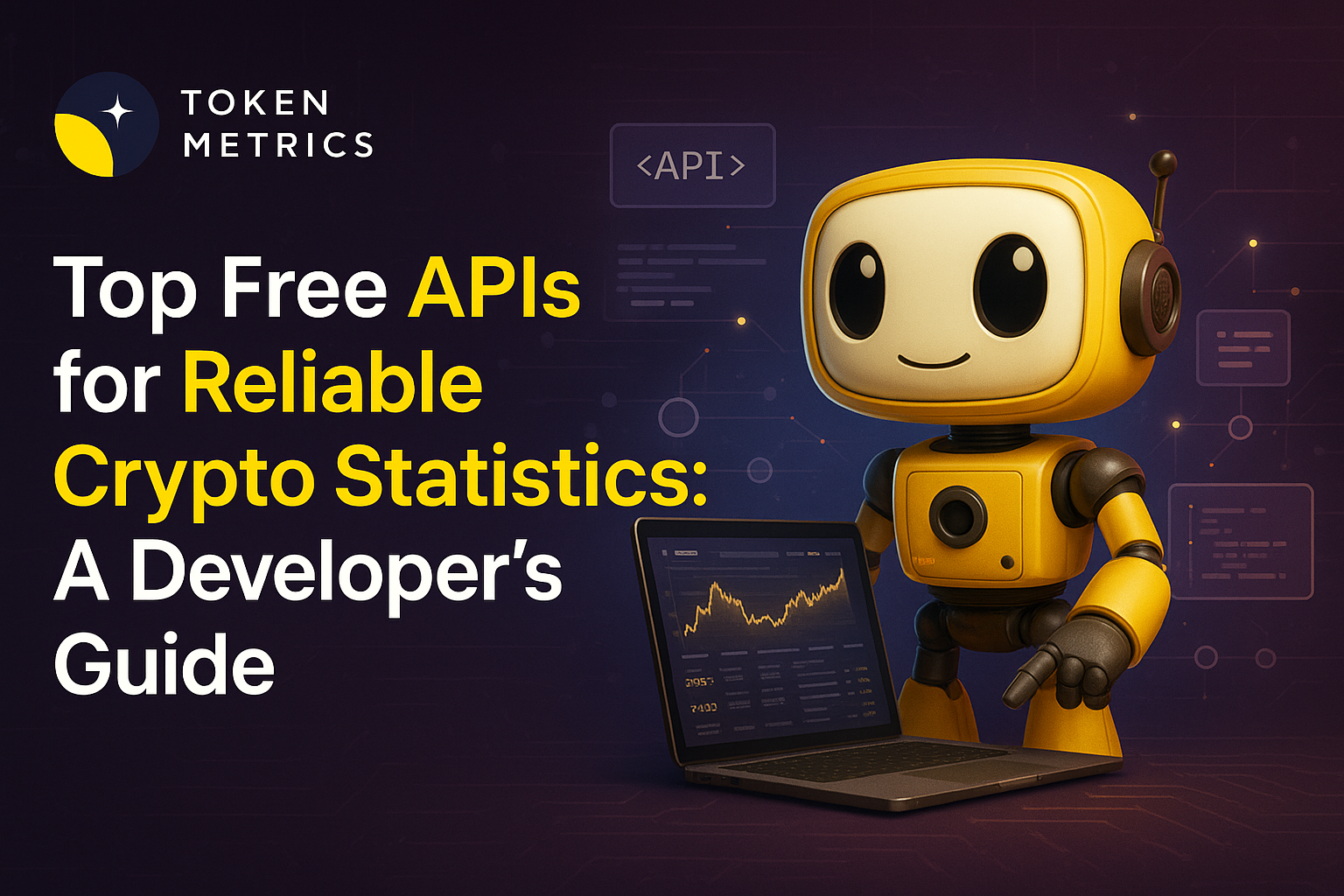
%201.svg)
%201.svg)
Whether you’re a crypto enthusiast building a portfolio tracker, a data scientist enhancing your research with blockchain statistics, or a developer powering an AI agent with on-chain data, the right API can unlock game-changing insights without hefty costs. As access to transparent crypto data becomes increasingly important, many turn to free APIs to gather reliable stats on digital assets—yet navigating the options can be daunting. In this guide, we break down some of the best free APIs for crypto statistics, what to consider when choosing one, and how developers leverage these tools for research, analytics, and building smarter applications.
A crypto API (Application Programming Interface) serves as a bridge between live blockchain data and your application or research workflow. These interfaces allow you to fetch real-time prices, historical charts, market capitalization, trading volumes, on-chain metrics, and sometimes deep project statistics. Unlike manual data collection, APIs automate the process, saving vast amounts of time and reducing human error. As web and AI applications increasingly rely on real-time digital asset data, choosing trustworthy and feature-rich APIs is critical for accuracy and efficiency.
Not all free APIs are equal. Here are some reputable platforms that provide complimentary tiers for accessing crypto stats, with a brief overview of their strengths:
Each API varies in terms of available endpoints, usage limits, latency, and scope. For many projects, especially AI-driven tools and bots, evaluating these criteria is just as important as price.
Before selecting an API, developers and data analysts should apply a systematic framework to ensure the tool matches their use case. Consider:
Researching these factors upfront will help avoid integration headaches later.
Free APIs empower a variety of users beyond developers—from quant researchers to hobbyists, and even AI tool builders. Some common applications include:
Free APIs are especially valuable for prototyping or academic work, allowing experimentation without financial barriers.
While many free APIs are robust, it’s vital to recognize their limits:
Always monitor usage and test with sample queries before deeply embedding an API into your application stack.
Build Smarter Crypto Apps & AI Agents with Token Metrics
Token Metrics provides real-time prices, trading signals, and on-chain insights all from one powerful API. Grab a Free API Key
Free APIs allow you to retrieve real-time prices, historical price charts, market capitalization, volume stats, and sometimes deep on-chain or social data. Common use cases include research dashboards, portfolio tracking, market research bots, and academic studies.
Paid APIs often offer higher request limits, lower latency, access to premium or advanced endpoints (such as AI signals or on-chain analytics), and priority support. Free APIs typically have limited features but are sufficient for basic research and prototyping.
Key limitations include lower request limits, restricted access to certain data types, potential delays in data refresh, and fewer customization options. Some free APIs may also reduce support or sunset features without notice.
Assess your needs: data types, frequency, project scale, and supported tokens or blockchains. Compare APIs on criteria like data coverage, uptime, rate limits, and ease of integration. Experiment with sample calls and consult developer communities for reviews.
Always review API terms of use and attribution requirements. Some APIs restrict redistribution or commercial use on free plans. Ensure compliance, especially if embedding data into public or monetized projects.
This article is for informational and educational purposes only. It does not constitute investment advice, endorsement, or a recommendation. Always do your own due diligence and consult a professional before using financial or blockchain data in critical applications.
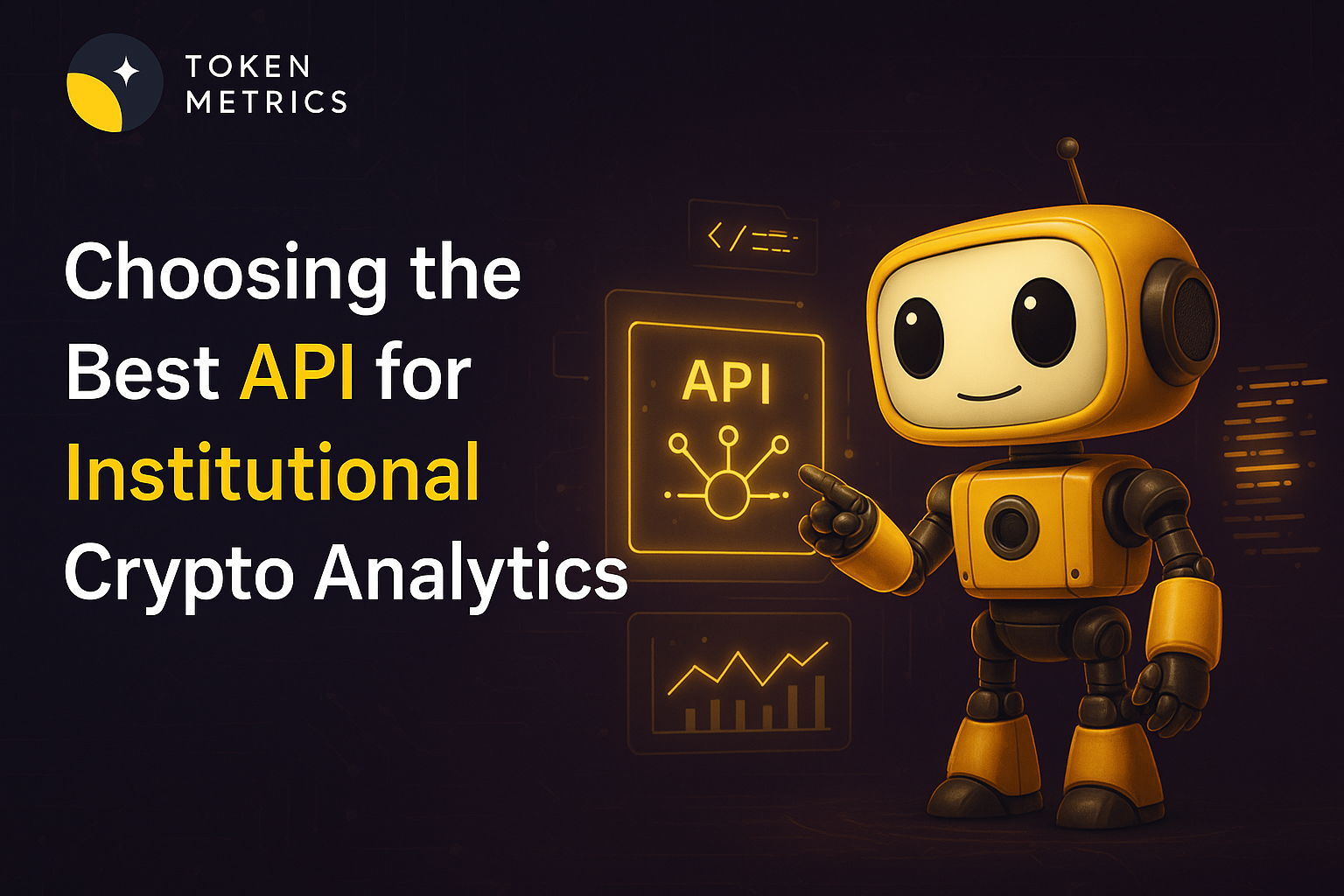
%201.svg)
%201.svg)
In today’s rapidly evolving digital asset landscape, institutions require access to secure, fast, and reliable analytics. The right application programming interface (API) can determine how effectively asset managers, risk teams, and research desks process vast volumes of crypto data. While hundreds of APIs claim to deliver comprehensive analytics, only a select few offer the depth, infrastructure, and granularity needed for institutional decision-making. So, how do you identify which API is best for institutional-level crypto analytics?
Institutions face unique analytics needs compared to retail participants. Core requirements cut across:
The ideal API brings together standardized endpoints, dedicated support, and tooling to enable advanced research, risk, and portfolio management functions.
Let’s explore some of the leading contenders in the market based on institutional needs:
While each API has unique strengths, the best fit depends on the institution’s specific research and operational objectives.
Given the diversity of provider offerings, institutions benefit from a structured evaluation approach:
Using this checklist, decision makers can align their analytics strategy and tooling to their mandate—be it portfolio monitoring, alpha research, or risk mitigation.
Recent advances in AI and machine learning have transformed how institutions derive insights from crypto markets:
For institutional users, the fusion of traditional data feeds with AI-driven signals accelerates research cycles, strengthens automation, and supports more granular risk monitoring.
Once the API shortlist is narrowed, institutions should:
Thoughtful integration enables institutions to maximize analytical rigor, improve operational efficiency, and streamline research and trading workflows.
Build Smarter Crypto Apps & AI Agents with Token Metrics
Token Metrics provides real-time prices, trading signals, and on-chain insights all from one powerful API. Grab a Free API Key
Top APIs offer comprehensive high-frequency data, robust uptime, on-chain analytics, and customizable endpoints. They support integration with institutional systems and provide enterprise-level security and support.
On-chain analytics reveal trends in wallet activity, fund flows, and network health. These insights can help with compliance monitoring, risk assessment, and understanding macro shifts in crypto markets.
AI-driven APIs can automate data aggregation, deliver predictive signals, analyze sentiment, and help institutions uncover hidden patterns—enhancing research speed and accuracy.
The Token Metrics API blends multi-source price, on-chain, and sentiment data with AI-powered analytics for actionable signals, supporting sophisticated institutional workflows.
Key challenges may include harmonizing data formats, managing API limits, ensuring security compliance, and aligning external feeds with internal data pipelines and tools.
This blog is for informational and educational purposes only. It does not constitute financial, investment, or legal advice. No warranties or endorsements of any API provider, platform, or service, including Token Metrics, are implied. Always conduct your own due diligence before integrating any data tool or service.
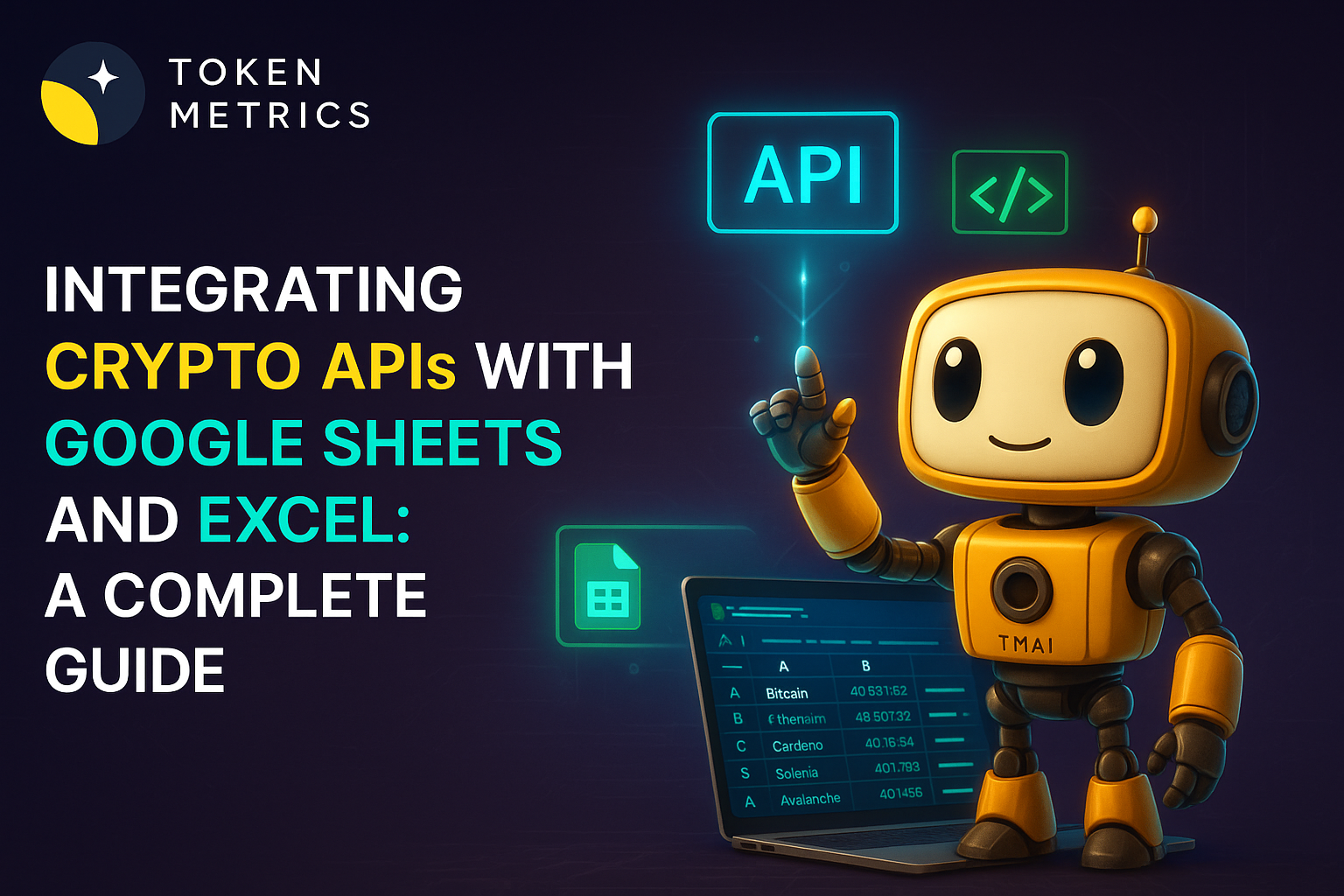
%201.svg)
%201.svg)
Staying on top of cryptocurrency markets often means harnessing real-time data and powerful analytics. For anyone seeking transparency and automation in tracking digital assets, connecting a crypto API directly to Google Sheets or Excel can transform your workflow. But how does the process actually work, and what are the best practices? Let’s break down the essential steps and considerations for integrating crypto APIs with your favorite spreadsheets, optimizing your data analysis, and ensuring reliability and security.
The first step is selecting a crypto API suited to your needs. APIs are digital interfaces that let apps and platforms request data from cryptocurrency exchanges or analytics providers. Popular APIs deliver live prices, on-chain data, market caps, historical charts, and blockchain analytics.
Examples of reputable APIs include Token Metrics, CoinGecko, CoinMarketCap, Binance, and CryptoCompare. Some, like Token Metrics, also offer AI-driven insights and advanced analytics for deeper research.
Google Sheets offers flexibility for live crypto data tracking, especially with tools like Apps Script and the IMPORTDATA or IMPORTJSON custom functions. Here’s a general approach:
=IMPORTDATA(“URL”) directly in a cell. For JSON APIs (the vast majority), you’ll likely need to add a custom Apps Script function like IMPORTJSON or use third-party add-ons such as API Connector.=IMPORTJSON("https://api.tokenmetrics.com/v1/prices?symbol=BTC", "/price", "noHeaders")). Crypto data will update automatically based on your refresh schedule or script triggers.Sample Apps Script for a GET request might look like:
function GETCRYPTO(url) {
var response = UrlFetchApp.fetch(url);
var json = response.getContentText();
var data = JSON.parse(json);
return data.price;
}
Change the URL as needed for your API endpoint and required parameters.
Microsoft Excel supports API integrations using built-in tools like Power Query (Get & Transform) and VBA scripting. Here is how you can set up a connection:
Note that Excel’s query limits and performance may vary depending on frequency, the amount of retrieved data, and your version (cloud vs desktop).
Why use a crypto API in your spreadsheet at all? Here are common scenarios and tips you should consider:
Security Tip: Always keep API keys secure and avoid sharing spreadsheet templates publicly if they contain credentials. Use environment variables or Google Apps Script’s Properties Service for added safety.
Although spreadsheet integration is powerful, some challenges are common:
When in doubt, consult your API provider’s resource or developer documentation for troubleshooting tips and best practices.
Build Smarter Crypto Apps & AI Agents with Token Metrics
Token Metrics provides real-time prices, trading signals, and on-chain insights all from one powerful API. Grab a Free API Key
Basic integrations, like using APIs that return CSV files, can often work without code via built-in data import features. For JSON APIs or custom data endpoints, familiarity with Apps Script (Google Sheets) or Power Query (Excel) is helpful but not strictly required, especially if you use add-ons like API Connector or plug-and-play solutions.
Supported APIs offer a variety of data: live spot prices, historical price series, market capitalization, volume, on-chain metrics, sentiment scores, and more. The exact data fields depend on each API’s offering and the available endpoints.
Never embed plain text API keys in shared or public spreadsheets. In Google Sheets, use script properties or protected ranges; in Excel, store keys locally or use encrypted variables if automating. Always follow your provider’s credential management guidelines.
Refresh frequency depends on your integration setup. Google Sheets custom scripts or add-ons can update as often as every few minutes, subject to service and API rate limits. Excel’s Power Query typically updates manually or based on scheduled refresh intervals you define.
Choice depends on use case and data depth. Token Metrics is notable for real-time prices, AI-powered analytics, and robust developer support. Other popular choices are CoinGecko, CoinMarketCap, and exchange-specific APIs. Always compare data coverage, reliability, security, and documentation.
This article is for educational and informational purposes only. It does not constitute financial, legal, or investment advice. Always follow best practices for security and usage when working with APIs and spreadsheets.


 Create Your Free Account
Create Your Free Account9450 SW Gemini Dr
PMB 59348
Beaverton, Oregon 97008-7105 US
.svg)




.png)
Token Metrics Media LLC is a regular publication of information, analysis, and commentary focused especially on blockchain technology and business, cryptocurrency, blockchain-based tokens, market trends, and trading strategies.
Token Metrics Media LLC does not provide individually tailored investment advice and does not take a subscriber’s or anyone’s personal circumstances into consideration when discussing investments; nor is Token Metrics Advisers LLC registered as an investment adviser or broker-dealer in any jurisdiction.
Information contained herein is not an offer or solicitation to buy, hold, or sell any security. The Token Metrics team has advised and invested in many blockchain companies. A complete list of their advisory roles and current holdings can be viewed here: https://tokenmetrics.com/disclosures.html/
Token Metrics Media LLC relies on information from various sources believed to be reliable, including clients and third parties, but cannot guarantee the accuracy and completeness of that information. Additionally, Token Metrics Media LLC does not provide tax advice, and investors are encouraged to consult with their personal tax advisors.
All investing involves risk, including the possible loss of money you invest, and past performance does not guarantee future performance. Ratings and price predictions are provided for informational and illustrative purposes, and may not reflect actual future performance.

